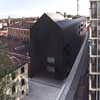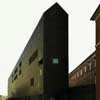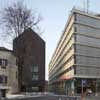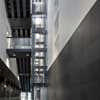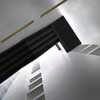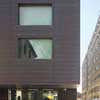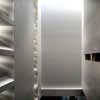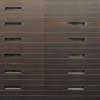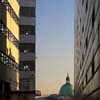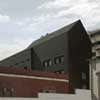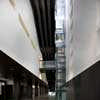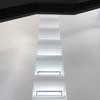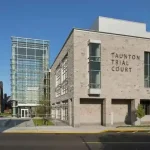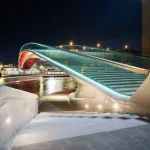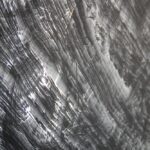LCV, Law Court Offices in Venice, Venetian Legal Building Project, Photos, News, Picture, Design
Law Court Offices in Venice Building
LCV Venezia, Italy design by C+S Associati Architects
18 + 17 Dec 2012
LCV. Law-Court Offices in Venice
Venezia, Italy
Design: C+S ASSOCIATI
This is the last completed work by this celebrated Italian architecture studio.
It recently won the special prize of the Gold Medal of Italian Architecture 2012.
English text (scroll down for Italian):
Inhabited infrastructure
The project is a winning entry of an international competition. The building is a graft in the complexity of the Venetian urban system facing Piazzale Roma, the car-entrance space to the city of Venice. At the same time it becomes the ‘infrastructure’ which brings an existing 19th century complex factory (Ex-Manifattura Tabacchi) to a contemporary use: in fact it houses the the technological systems serving the whole.
The dimension of the building is measured on the huge void of Piazzale Roma facing the bridge of Santiago Calatrava, on the opposite side.
A huge, five level high space acts as a ‘urban entrance’ enlightened by the roof as all the ex-industrial existing buildings.
This vertical inner space, opened to free entrance during the day, will house, on the ground level, the commercial services which will allow to improve and give back the citizen a big public space, functioning also as an entrance to the sequence of public spaces which will be regained by the future restoration of the existing buildings.
The new volume has a simple, archetypical, compact shape, resulting from the manipulation of the Venetian industrial building typology and the connection to the skyline of the huge parking lots.
A five meter long cantiliver on Piazzale Roma becomes the entrance: a huge shadow which attracts the fluxes of people horizontally in the new urban system and vertically along either a linear stair or elevators which distributes to all the levels.
The linear stair is designed parallel to the elevation facing the parking building San Marco, letting us to design that elevation as a punctuation of small windows designing a special natural light in the inside.
The material of the building is a preoxidated type of TECU copper. Copper in Venice is the material with which all the institutional (religious and laic) buildings’ roofs are built with. In this projects, materiality and form become a metaphor representing institution: the house of justice is a big monomateric roof which welcome the citizens inside an enlightened space. We always work with materiality and light, instigating, with pro-oxidation, the idea of subtracting material from surfaces and activationg them with light, which is what time does. Working with the idea of ‘time’ is archetypical in Venice.
Italian text:
LCV Venezia
Infrastruttura abitata
Il progetto, vincitore di un concorso internazionale di progettazione nel 2002, è l’occasione per restituire alla città di Venezia un’area inaccessibile. Il complesso della Ex-Manifattura Tabacchi a Piazzale Roma diventerà la sede del nuovo tribunale di Venezia, accorpando tutti gli uffici giudiziari, che in questo momento sono distribuiti in diversi Palazzi storici. L’iter del progetto è stato complesso, come prassi per i grandi lavori pubblici in Italia.
Senza voler entrare nelle lungaggini burocratiche e amministrative di dieci anni nei quali il lavoro si è protratto, l’edificio che presentiamo è il primo ad essere terminato.
E’ una lama che si innesta nell’unico vuoto esistente nell’area progetto che si affaccia su piazzale Roma.
E’ la grande hall di ingresso necessaria a distribuire i flussi che rigenerano una parte importante della città di Venezia.
E’, allo stesso tempo, l’infrastruttura che permette di rigenerare il sistema degli edifici esistenti.
Il primo tema su cui abbiamo lavorato è la manipolazione del programma proponendo l’ibridazione di un edificio pubblico che fosse al contempo un’infrastruttura.
Due piani dell’edificio, infatti, ospitano tutti gli impianti tecnologici (centrali termiche e frigorifere) che permetteranno il riuso dell’intero sistema della Manifattura Tabacchi. Il volume inoltre ospita (ai piani superiori) uffici del tribunale di sorveglianza, cancellerie e archivi. La grande hall di ingresso, aperta alla città di giorno, ospiterà spazi commerciali (tabaccheria, bar, negozi) innervando il sistema degli spazi pubblici (campi e campielli interni) restituiti al tessuto urbano veneziano.
Il secondo tema del progetto è relativo alla scala dell’intervento e all’impianto tipologico. La dimensione dell’edificio si confronta alla scala urbana sia con il grande vuoto di Piazzale Roma, essendo posizionato sul fronte opposto al ponte di Calatrava, sia con la dimensione generosa del vuoto degli edifici ottocenteschi della Ex-Manifattura Tabacchi, volumi di grande suggestione spaziale, per la grande parte caratterizzati da un sistema di illuminazione zenitale.
Il nuovo volume ha una forma semplice e compatta, tipologicamente è una tesa contemporanea manipolata in altezza per connettere lo skyline dei volumi dei parcheggi multipiano al sistema urbano delle tese industriali ottocentesche. Verso Piazzale Roma, il volume non si appoggia a terra.
Uno sbalzo di cinque metri su Piazzale Roma diventa l’ingresso: un’ombra che accoglie i flussi riorientandoli all’interno del nuovo sistema: una compressione che esplode all’interno in uno spazio di sette piani illuminato dall’alto su cui si svolge una scala metallica, che distribuisce a tutti i piani dell’edificio e che permette di disegnare il fronte verso il garage San Marco con una sequenza di piccole bucature, quasi una sequenza di codici che punteggiano la facciata.
Il terzo tema del nostro lavoro riguarda la materia. Il materiale che utilizziamo all’esterno è rame preossidato TECU: il rame è a Venezia il materiale che caratterizza le coperture degli edifici monumentali. In questo progetto il materiale diventa la metafora che rappresenta l’istituzione, la ‘casa della giustizia’ e che, come un grande tetto manipolato ed estruso accoglie i cittadini in uno spazio, luminoso e trasparente. Il processo di preossidazione del rame rievoca il modo in cui il tempo agisce sulle superfici con un processo di sottrazione della materia. Anche la materia, oltre al programma e all’impianto tipologico, viene manipolata per introdurre subito l’edificio nel tempo veneziano di cui è parte. Pur nelle sue dimensioni generose, l’edificio appare quasi come la sua ombra, una tesa in bilico tra storia e contemporaneità.
LCV. Law-Court Offices in Venice images / information from C+S Associati
C+S Associati Architects
Location: Venice, Italy
Venice Architecture
Venice Architecture Designs – chronological list
Venice Architecture Walking Tours
Venetian Architecture – Selection
Fondaco dei Tedeschi
OMA
Fondaco dei Tedeschi
Jesolo Lido Condominium Buildings
Richard Meier & Partners Architects LLP
Jesolo Lido Condominium
Quarto Ponte sul Canal Grande – Bridge
Santiago Calatrava Architects
Quarto Ponte sul Canal Grande Venice
Website: Visit Venice
Comments / photos for the LCV. Law-Court Offices in Venice Building – Venetian Architecture page welcome

